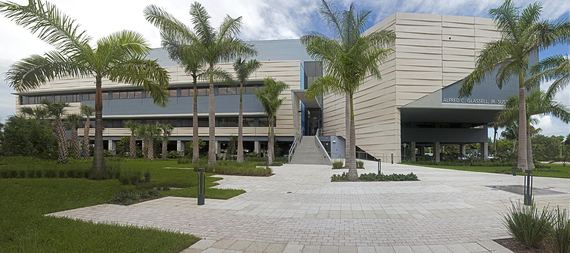On October 2, the Rosenstiel School of Marine and Atmospheric Science at the University of Miami further solidified its academic and research leadership with the dedication of a 86,000 square foot building, complete with a wind-wave-storm surge simulator able to produce Category 5 force winds.
"This facility makes it possible for us to do research right where the atmosphere and the ocean meet. We are at the leading edge of science," explains Roni Avissar, Ph.D., dean of the Rosenstiel School of Marine and Atmospheric Science.
"With a 38,000 gallon seawater complex, we have the largest three-dimensional, controllable test environment where we can study the impact of high winds and how the air and sea interface in some of the most demanding conditions. For the first time, this makes it possible to bridge theoretical and practical research so that we can better understand and forecast hurricane intensity."
The Marine Technology and Life Sciences Seawater Complex at the Rosenstiel School brings together two distinct laboratory facilities.
The Alfred C. Glassell, Jr. SUSTAIN Building (SUrge-STructure-Atmosphere INteraction) houses the hurricane simulator. Wind and waves combine to move seawater at speeds up to 150 mph where the interaction can be measured and controlled and the impact on coastal structures can be studied in a 3D environment. The force of hurricanes is created by a 1400 horsepower fan and a paddled wave generator to push the seawater, all inside a gigantic wave tank- roughly 75 x 19 x 6 feet - and enclosed all around in clear, three inch thick acrylic so that every spray and movement of the water and wind can be monitored from the outside.
Attached by a walkway, the Marine Life Science Center houses laboratories for the study of marine organisms - holding, spawning and rearing - and for researching the impact of climate change on coral reefs. Given the Rosenstiel School's leadership in aquaculture, the Center makes possible new research into sustainable fish farming with a goal of much improved nutrition, ensuring disease control and protecting early life stages in certain fish species.
"At the Rosenstiel School we have a clear focus on two areas. We need to do the finest research in marine and atmospheric science and we need to produce the best trained scientists for the future," says Dean Avissar. "As an integral part of the University of Miami, both are critical. These facilities give us a platform for both like never before."
See YouTube:
Over 10 years of planning and breaking ground in the summer of 2012, the complex took two years to construct and cost roughly $50 million. Cambridge Seven Associates, the award-winning architecture and engineering firm, designed the building with a focus on not only functionality and striking design but the University of Miami's goal of a sustainable approach to all its structures from the perspective of both the environment and conservation.
A project of this magnitude is only possible through support from a wide range of institutions and benefactors.
In Dean Avissar's remarks at the dedication, he added: "It takes literally a village to build the kind of facility we're opening here today." He recognized some of the many individuals who played key roles in making the facility possible, including Brian Haus, Ph.D., Professor of Ocean Sciences, who designed the seawater tank and helped spearhead a $15 million NIST grant that partly funded the building's construction. In addition to the Glassell Family Foundation, generous gifts from the Marta Weeks Family and the G. Unger Vetlesen Foundation made the building possible.
From a quiet start in the 1940s with only a few tropical buildings on Virginia Key, just off Miami on the way to Key Biscayne, the Rosenstiel School of Marine and Atmospheric Science has become one of the leading oceanic and atmospheric research and teaching institutions in the world.
Today, with the completion of the Marine Technology and Life Sciences Seawater Complex, it likely catapulted to the top of the list.

